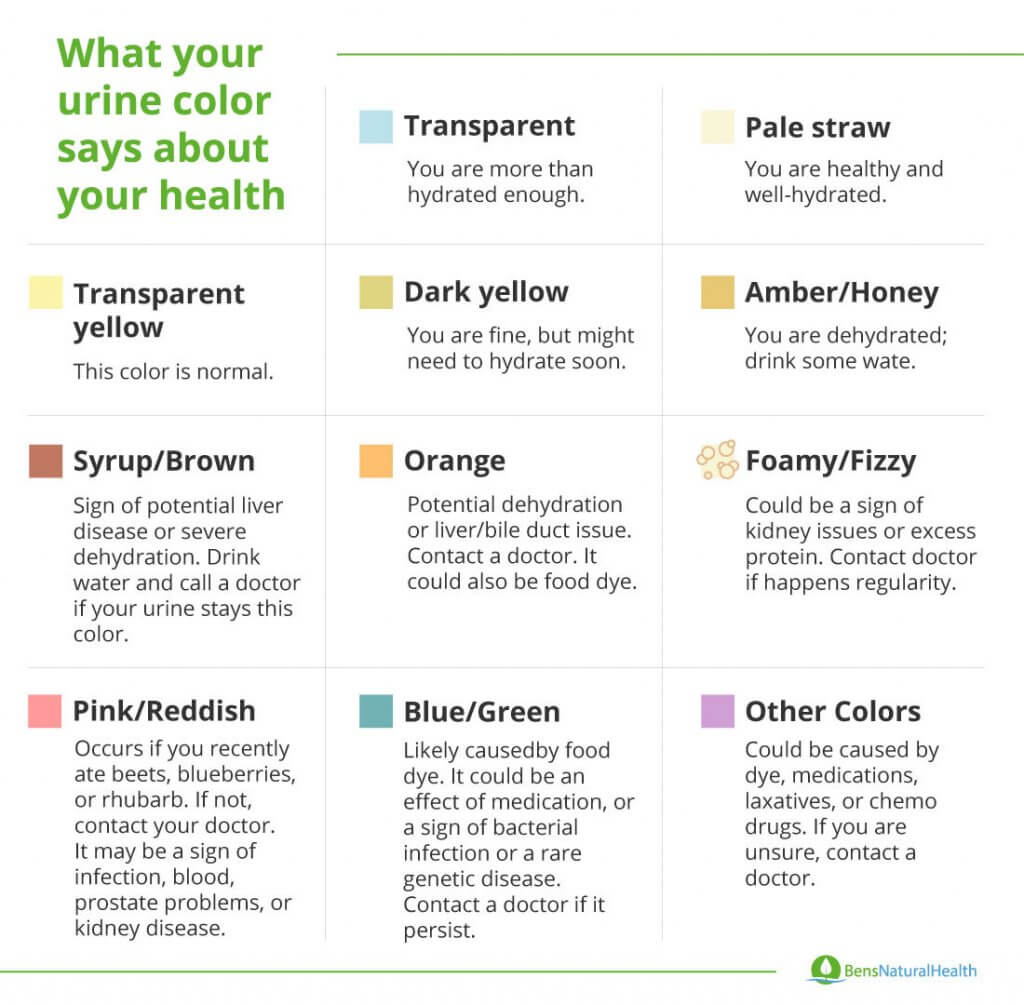- Q: Can the color of my urine indicate a health issue?
- Q: What do different urine colors mean and what causes them?
- Q: What procedures are used to diagnose the cause of abnormal urine color?
- Q: When should I see a doctor about changes in the color of my urine?
- Key FAQs on Urine Color Meaning
- Conclusion
- Our Medical Review Process
- Our Editorial Guidelines
- Medical Disclaimer
- Source
Keeping an eye on your urine color can help notice specific health issues. It can help with the process of early diagnosis and getting treated as soon as possible.
That is why doctors often use urine tests to confirm or eliminate potential causes of the present symptoms. We will discuss the different urine colors and explain each color’s possible causes in today’s article.
To provide comprehensive medical insight into what color should urine be, we interviewed Dr. Ilija Kelepurovski, a licensed medical doctor with expertise in nephrology and general internal medicine.
In our discussion, Dr. Kelepurovski addressed direct questions about the clinical significance of urine color, referencing common variations such as amber color urine and healthy urine color. His expert opinions on the normal color of urine, along with interpretations of the urine color chart, were obtained during the interview process to ensure accuracy and relevance.
All information in this article has been reviewed and is based on medically sourced content, upholding the highest standards of clinical reliability for readers seeking authoritative information about urine color and its diagnostic significance.
Q: Can the color of my urine indicate a health issue?
Dr. Kelepurovski answers: Yes, the color of your urine can provide significant information about your overall health. The normal urine color is generally described as yellow or amber, which is due to the presence of a pigment known as urochrome. However, abnormally colored urine can be an early sign of underlying health issues. Various factors such as the time of day, hydration status, diet, or certain medications can influence urine color. Sometimes, small changes in urine color are not alarming, but persistent or unusual changes warrant attention.
More Serious Conditions that Affect Urine Color
Hematuria (blood in urine) – Can appear anywhere from pink to cola-colored depending on concentration. Blood is caused by something like infections, kidney stones, trauma, glomerular disease, or malignancies.
Hemolytic anemia – Can also cause dark urine due to excess free hemoglobin being filtered by the kidneys.
Liver disease – Can cause the urine to be dark brown or orange due to bilirubin spilling into the urine.
Rhabdomyolysis – With muscle breakdown, there are muscle breakdown products like myoglobin in the urine, and this may make the urine dark brown to “tea-colored.”
Urinary tract infection (UTI) – Can present cloudy urine due to pyuria (white blood cells), hematuria and sometimes a bad smell.
Kidney failure – Can result in urine appearing darker or foamy urine due to proteinuria.
Medications and Supplements – Many medications and supplements may change the color of urine:
Rifampin → red/orange
Nitrofurantoin → brown
B-complex vitamins → bright yellow
Amitriptyline or Indomethacin → green/blue
It’s important to remember that while many changes in urine color may be benign or related to dietary factors, some can suggest serious conditions. The context of other symptoms and your hydration level plays a key role in the assessment. If you notice a persistent or dramatic alteration in your urine, it is wise to consult a healthcare professional for further evaluation on what the color of urine may mean for your health.
Q: What do different urine colors mean and what causes them?
Dr. Kelepurovski answers: Observing different urine colors is actually quite common, and interpreting them can help you understand important cues about your health. While healthy urine color typically ranges from pale straw to deep amber, depending on hydration, urine color meaning can extend far beyond yellow. Here’s a breakdown, supported by a urine color chart, of what certain urine colors may indicate, along with associated causes:

Clear urine
Clear or transparent urine often indicates robust hydration. If your urine is always clear, you might even be overhydrated, and it may be wise to slightly reduce water intake. You can review what clear or transparent urine means. Overhydration isn’t usually harmful, but maintaining balance is key for optimal health.
Pale straw and transparent yellow urine
This normal urine color signals that your kidneys are functioning well and you are appropriately hydrated. This is considered the textbook healthy urine color, and it’s what you should aim for on a daily basis.
Dark yellow urine
Dark yellow urine commonly appears in the morning due to overnight concentration. While this is generally not concerning for healthy adults, persistent dark yellow urine throughout the day may suggest you’re not drinking enough water and could be heading towards dehydrated urine color.
Amber-colored urine
Amber or honey-colored urine is similar to dark yellow but typically points to dehydration. Try drinking a glass or two of water and see if the color lightens. Chronic amber urine may suggest underlying concerns and merits further evaluation.
Light orange urine
Light orange urine also commonly points toward dehydration. However, certain medications and foods can contribute. If the orange tinge persists after hydration, consider discussing this with your healthcare provider.
Orange urine
Orange urine may indicate dehydration, but it can also point to more serious issues such as jaundice or liver problems. In cases of liver or bile duct disease, you may also notice additional symptoms like pale stools, fatigue, nausea, or vomiting. For more information about liver-related causes of abnormal urine color, please review reputable resources.
Dark orange, almost brown-colored urine
Severe dehydration may cause urine to appear dark orange or nearly brown. If color remains after adequate hydration, possible causes include jaundice, Gilbert’s syndrome, or severe muscle breakdown (rhabdomyolysis). If you notice such colors, swift medical assessment is recommended.
Dark brown-colored urine
This may be a side effect of certain medications (such as metronidazole), severe dehydration, or excessive consumption of certain foods (aloe, fava beans, rhubarb). Significantly, dark brown or even “Coca-Cola” colored urine can signal hepatitis or advanced liver disease, known as choluria. Urine that appears nearly black requires prompt medical evaluation, as it could indicate serious health threats.
Pink or red urine
Pink or red urine doesn’t always signal blood in the urine (hematuria). Eating foods like beets, blueberries, or rhubarb can change urine color to pink or red due to natural pigments. However, without dietary triggers and especially when accompanied by other symptoms, red or pink urine warrants medical assessment. Causes include urinary tract infection, kidney stones, bladder or kidney cancer, and other conditions causing hematuria.
Green urine
Most often, eating asparagus causes temporary green urine color (and a distinctive odor). Certain medications, dyes, or bacterial infections can also produce green urine, as shown in case studies on unusual urine color.
Blue urine
Although rare, blue urine can result from certain medications or medical dyes, but most commonly from a genetic disorder called familial hypercalcemia (blue diaper syndrome), a condition impacting tryptophan breakdown in the gut.
Purple urine
Purple urine is extremely rare and typically associated with “purple urine bag syndrome”, seen mostly in individuals with urinary catheters and concurrent bacterial urinary infections. For more details, review insights on catheter-related complications.
White/milky urine
An abundance of minerals, such as calcium and phosphorus, or higher protein content, can give your urine a milky or cloudy appearance. Infection can also play a role, and it may be seen in some cases of UTI urine color abnormalities.
Cloudy urine
Cloudy urine can stem from dehydration, urinary tract infection, or kidney disease, and may sometimes include foam due to protein (pneumaturia). Foamy urine can be a red flag for more serious conditions such as diverticulitis or Crohn’s disease.
If you’re curious about what color urine is expected in specific situations, such as early pregnancy urine color, keto diet urine color (sometimes bright yellow), or the color of urine when dehydrated, reference a validated urine color chart as a helpful guide. Still, if urine turns a strange color suddenly and persists, always reach out to a healthcare provider for clarification.
Q: What procedures are used to diagnose the cause of abnormal urine color?
Dr. Kelepurovski answers: If you present with an unusual or persistent change in urine color, your doctor will follow a systematic evaluation to pinpoint the cause. The diagnostic workup usually begins with a detailed medical history and a thorough physical examination. It’s essential to inform your provider of any history of urinary tract disorders, medications, recent dietary changes, or family history of kidney or liver disease.
The primary laboratory test for urine color concerns is a urine analysis (urinalysis). Your urine sample is examined for abnormalities such as red blood cells, minerals, high protein levels, glucose, or signs of infection. A urinalysis can reveal early clues about infections, kidney dysfunction, diabetes, or liver problems, and indicate the need for further testing.
Blood tests are also important to assess kidney function (creatinine and blood urea nitrogen levels), possible kidney disease and liver enzyme levels, as well as blood sugar profiles for suspected diabetes. Elevated levels of these substances in your blood rather than in your urine may signal an issue with filtration or organ function.
If necessary, additional imaging (such as ultrasound or CT), cystoscopy, or referral to a specialist may be recommended, particularly if there is ongoing concern about kidney stone urine color, UTI urine color, cancer, or other systemic health issues.
Imaging studies
Kidney-bladder ultrasound – An easy, inexpensive first-line screening test to identify hydronephrosis, masses, or large stones.
CT or MR urography – Provides detailed cross-section oriented images and is especially useful in the detection of stones, tumors, or unexplained hematuria in the context of prior non-diagnostic ultrasound.
Plain abdominal CT – Usually ordered in the setting of concern for kidney or ureteric stones.
Cystoscopy – A flexible scope is inserted through the urethra to directly visualize the lining of the bladder. Cystoscopy is indicated in most high risk hematuria patients, and also those with irritative urinary symptoms that cannot be explained by other investigations.
Referral to a specialist – Patients who have persistent abnormality, or have possible malignancy, or have laboratory findings of complex metabolic or liver problems may be referred to a urologist, nephrologist, hepatologist, or infectious disease specialist to evaluate or obtain a biopsy.
Q: When should I see a doctor about changes in the color of my urine?
Dr. Kelepurovski answers: It’s always prudent to talk to your doctor if you’re concerned about changes in urine color, but some signs are cause for urgent evaluation. You should seek prompt medical care if you notice blood in your urine (pink, red, or cola-colored), which may be a sign of hematuria, or if you experience persistent, unexplained amber or orange urine, as these can be signs of kidney or bladder disease that need timely attention.
In cases of possible infection or other serious signs, early recognition and treatment may prevent complications. If you are scheduled for a urine test, be sure to avoid certain foods 24 hours before the test, including those known to alter the color of your urine (like beets or rhubarb), to help ensure accurate results. In summary, if you are ever unsure whether the color of your urine is normal or associated with an underlying health concern, don’t hesitate to reach out to your healthcare provider for advice and consideration of a urine color chart to guide your next steps.
Key FAQs on Urine Color Meaning
Q: What does the urine color chart infection reveal about possible urinary tract or kidney infections?
Dr. Kelepurovski answers: In urinary-tract infections, a significant amount of white-blood cells, (or) bacteria, and (or) crystals are present to scatter the light and will make the urine cloudy or milky-white. There is usually an associated foul smell, burning sensation, and/or urgency that could also be noticed along with the cloudy urine. On the other hand, blood from either a stone or tumour usually makes urine pink-red or cola-brown, and an abundance of vitamins may make urine neon-yellow. If you experience cloudy urine for more than 24 hours or you notice cloudy urine with pain (and/or) fever, you should contact your clinician.
Q: What changes in early pregnancy urine color should expectant mothers be aware of, and when is it a concern?
Dr. Kelepurovski answers: In early pregnancy, having mildly dark-yellow urine is normal and is typically related to dehydration or the bright dyes in prenatal vitamins. Having clear urine means that you are well hydrated. Just because you are having clear urine does not mean that there is no risk. However, if your urine is brown-orange (possible liver issues or dehydration unresponsive to saline), cloudy with burning (UTI risk increases in pregnancy), or literally bloody, you should seek medical help.
Q: What are the common signs of kidney stone urine color, and how can I tell if my urine changes might be due to a stone?
Dr. Kelepurovski answers: Stones can irritate the urinary lining, causing a pink, red, or cola-colored urine (gross hematuria). The bleeding associated with stones is often more intermittent than in event of a UTI and is usually accompanied by episodic flank pain or cramping as the stone travels. If you have red or brown urine and sharp pain in your back or side, seek a doctor or an emergency department for imaging and pain management.
Q: Does b complex change urine color, and why does this sometimes happen after taking vitamins?
Dr. Kelepurovski answers: Riboflavin (vitamin B₂) is water-soluble and rapidly excreted in large amounts, giving urine a vivid “highlighter” yellow color. This change is harmless and simply indicates that you have more B-vitamins than the body can store in tissues at that time
Q: What color is urine when your kidneys are failing, and what other symptoms should I watch for?
Dr. Kelepurovski answers: Chronic or acute kidney failure may produce dark-amber, brown, or even red urine since the kidneys are not able to remove blood and waste pigments well. Other warning signs are foamy urine (loss of protein), swollen ankles, ongoing tiredness and loss of appetite. If there is persistent darkening and one or more of these symptoms, it’s time to seek medical evaluation immediately.
Q: How does hiv urine color present, and are there specific changes linked to HIV or its medications?
Dr. Kelepurovski answers: HIV does not change the colour of urine; its complications and drugs can cause urine colour changes. Persistent foamy—sometimes faintly pink—urine probably means protein is leaking due to HIV-associated kidney disease and should be evaluated. Also, urine that is yellow-brown or colas-looking colour usually is the result of increased bilirubin from antiretrovirals called protease inhibitors like atazanavir or indinavir and will resolve when the drug is changed, however using rifabutin for secondary prevention or treatment of M. avium infections can make urine bright orange to brown, simply because the capsule colour is orange. However, if very dark “tea” urine is seen with pale stools or yellow skin this indicates possible true liver injury from efavirenz or similar medications, and a medical review for this condition will be urgent. Also, visible blood, cola-coloured urine or foam urine lasting longer than a day should be evaluated quickly.
Q: What are the typical chlamydia urine color changes, and can urine color alone help diagnose this infection?
Dr. Kelepurovski answers: Chlamydia typically doesn’t distort urine colour.
When it does affect appearance, the urine may be cloudy or milky as the infection promotes the shedding of white-blood-cell (pus) into the stream. Sometimes a small amount of blood makes it faintly pink, but that overlap also occurs with the other STIs, and urinary-tract infection or stones. Since those colour changes are nonspecific—and many cases of chlamydia didn’t produce any visible colour change whatsoever—doctors instead will use a nucleic-acid amplification test (NAAT) on first-catch urine or a swab—not colour—to confirm the diagnosis.
Conclusion
Understanding what color your urine should be can help you keep track of your health in a simple way. In most cases, healthy urine color ranges from pale yellow to a light amber shade, this means you’re probably well-hydrated and your body is working as it should.
Sometimes, urine color can change because of what you eat, certain medicines, or how much fluid you’ve had that day.
For example, vitamins or antibiotics may add a brighter or darker tint, and not drinking enough water can make your urine look darker yellow. On the other hand, very clear urine might mean you’re drinking a lot of fluids. While unusual colors like red, orange, or very dark brown may happen for harmless reasons, it’s helpful to pay attention if these colors last more than a day or are paired with other symptoms, such as pain or fever. If you ever feel worried about a sudden or long-lasting change in your urine color, it’s always a good idea to talk with a healthcare provider. Remember, your body often gives gentle clues when something needs attention, and noticing these changes is just another way to care for yourself each day.
Our Medical Review Process
At Ben’s Natural Health, we are committed to providing transparent, scientifically accurate information with clear communication. All our articles are created by qualified medical professionals, then reviewed every 12 to 24 months to ensure all information is current, well-researched, and firmly grounded in credible studies. We reference only peer-reviewed research and studies from reputable medical journals. Every article includes comprehensive citations and direct links, enabling you to verify the accuracy of our claims. If you want more details about our standards and review procedures, please visit our medical review process.
Our Editorial Guidelines
Ben’s Natural Health has delivered trustworthy, evidence-based health information for more than 25 years. Our strict editorial standards guarantee the reliability of everything we publish. Our content is drafted by certified experts in their fields, doctors, registered dietitians, nutritionists, fitness professionals, or surgeons, and carefully reviewed for accuracy. The credentials, relevant experience, and bios of our contributors are always accessible and linked at the beginning of each article. Discover how we create and verify our content by reviewing our editorial guidelines.
Medical Disclaimer
The details shared on this blog are provided solely for general informational purposes and are not a substitute for professional health advice, diagnosis, or treatment. While the articles are authored by licensed physicians and undergo a medical review, they do not offer individualized medical guidance. Always consult your doctor or another qualified healthcare practitioner about any questions related to your personal health. Do not ignore professional medical advice or postpone seeking it because of content found on this blog. Any use of information on this site is entirely at your own risk.






